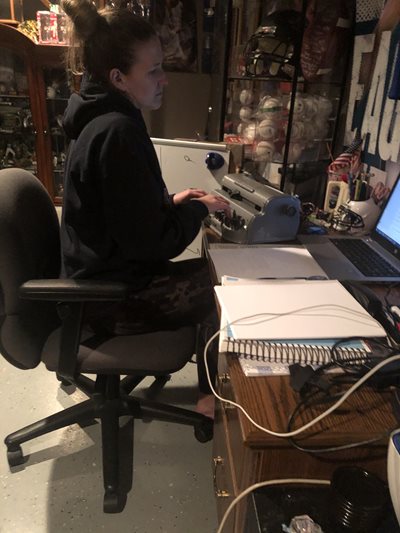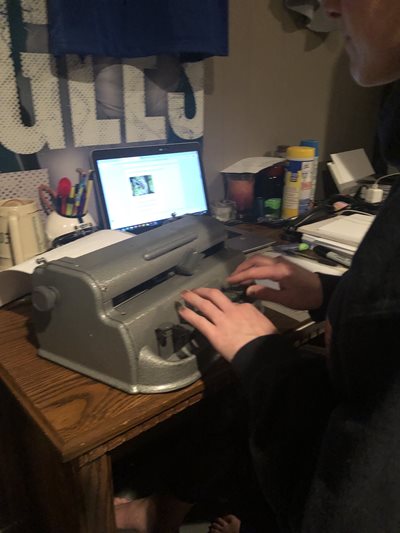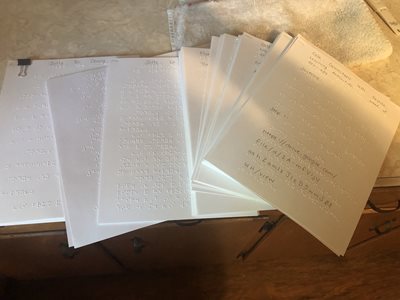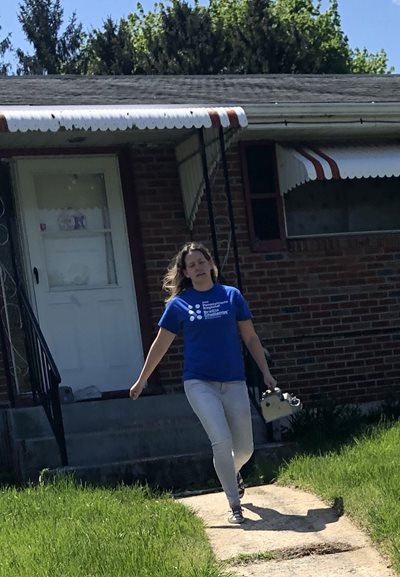 One of the many things the pandemic has taught Sheri Hoffert ’20O&M, an Orientation and Mobility (O&M) student in the Blindness and Low Vision Studies (BLVS) program at Salus University, is that she can be quick on her feet when it comes to helping her students.
One of the many things the pandemic has taught Sheri Hoffert ’20O&M, an Orientation and Mobility (O&M) student in the Blindness and Low Vision Studies (BLVS) program at Salus University, is that she can be quick on her feet when it comes to helping her students.
She’s also had to practice what she preaches to her students: Take a deep breath and try not to get frustrated. If you do, walk away, take a break and then come back.
Prior to the COVID-19 pandemic, a typical day for Hoffert involved traveling between school buildings and districts to provide services and teach students who are visually impaired. But then the virus hit and schools and teachers had to react quickly.
Hoffert, who works for Berks County Intermediate Unit, had two students who were using a combination of braille and print materials for their schoolwork. When students were sent home, Hoffert collaborated with O&M specialists and other Teachers of the Visually Impaired (TVIs) to pull together resources and information that would best help students learn from home.
 One big issue to tackle was that all the technology Hoffert needed to create braille assignments for the students was at the school and not at her home.
One big issue to tackle was that all the technology Hoffert needed to create braille assignments for the students was at the school and not at her home.
“So I got an old-school Perkins brailler — it’s like a typewriter, but for braille — and everything my students need every week I hand-braille for them,” said Hoffert.
But that’s not all. Using the online Zoom meeting platform to work with her students, she not only had to gather weekly assignments from various teachers and translate those assignments into braille by hand, but then she had to actually get those assignments to the students.
So one day a week, Hoffert drives to each student’s house and drops all the materials they need for the week onto the front porch for the families to pick up.
“I have one student whose family is continuing to work, so they are careful of things but they’re not as worried because they’re all still out and about with their jobs,” said Hoffert. “I have another family, that student already has a compromised immune system and so does his mom. So it’s a little bit trickier planning his drop-off of materials because they go through a full 24-hour quarantine of everything that is outside of their home before they bring it inside. I have to take it over a day earlier.”
The reverse is true when the completed assignments have to go back to the various teachers, who use the Google Classroom platform to collect many of the completed assignments from the students.
 “My students will use the brailler to help follow along with the computer, but then they have the option — whatever works for them — to type in their work on the computer to turn it in like all of the other students, or they braille it out and email it to me. Then I have to read it and put it in print so their teachers can understand what they wrote,” said Hoffert.
“My students will use the brailler to help follow along with the computer, but then they have the option — whatever works for them — to type in their work on the computer to turn it in like all of the other students, or they braille it out and email it to me. Then I have to read it and put it in print so their teachers can understand what they wrote,” said Hoffert.
One innovation that Hoffert got from a colleague was to provide dry erase boards and markers for the families of visually impaired students. The eraser picks up the ink from the marker off the board, and then the eraser can be used to rub over the top of braille dots, which gives the dots color.
“Because the braille dots pick up that color, when they take a picture of it and email it, I can easily read the dots and tell what their braille says,” she said.
Problem-solving for her visually impaired students has become commonplace in the new normal of virtual teaching, according to Hoffert.
 “We kind of keep going and when we hit a problem, we have to stop and try to gather what we know and how to solve that problem,” she said.
“We kind of keep going and when we hit a problem, we have to stop and try to gather what we know and how to solve that problem,” she said.
None of the recent challenges, though, take away from Hoffert’s passion for teaching visually impaired students. And, she has been impressed with the resiliency of her students and the way they have navigated the challenges brought on by the pandemic.
“When you think about what they do on a daily basis, to access the same materials that other students do without being able to see them the same way,” she said. “Then you throw them into an environment where they’re stuck in their homes and their only access to the outside world is through their computers, which typically can be hard for people to learn how to navigate that are without vision or with low vision. To see my students who are only in fourth grade and sixth grade mastering these different skills and being able to use them with no problem, it just really makes me happy that this is what I do for a living.”